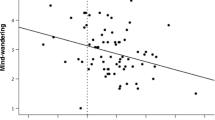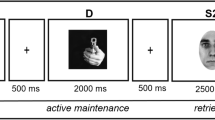Abstract
We investigated the relation between implicit sequence learning and individual differences in working memory (WM) capacity. Participants performed an oculomotor version of the serial reaction time (SRT) task and three computerized WM tasks. Implicit learning was measured using anticipation measures only, as they represent strong indicators of learning. Our results demonstrate that anticipatory behavior in the SRT task changes as a function of WM capacity, such that it increases with decreased WM capacity. On the other hand, WM capacity did not affect the overall number of correct anticipations in the task. In addition, we report a positive relation between WM capacity and the number of consecutive correct anticipations (or chunks), and a negative relation between WM capacity and the overall number of errors, indicating different learning strategies during implicit sequence learning. The results of the current study are theoretically important, because they demonstrate that individual differences in WM capacity could account for differences in learning processes, and ultimately change individuals’ anticipatory behavior, even when learning is implicit, without intention and awareness.



Similar content being viewed by others
Availability of data
The data set supporting the conclusions of this article is available as an electronic supplementary material. The data set is also available at https://doi.org/10.25500/00000379. The R code necessary to reproduce our models is available at https://github.com/ooominds/Working-memory-affects-anticipatory-behavior.
Notes
Note that including a set of additional predictors (i.e., age, gender, and education) did not improve the models (for more details and an additional control model containing a measure of executive function using a subset of participants, see Supplementary Material, Tables S3 and S4).
Because our sample size was relatively small and the size of the effects of interest could not be inferred from previous research, we addressed the potential power and parametrization bias issues by conducting a corresponding set of analyses using Bayesian estimation. Note that the estimates from the frequentist and Bayesian models were largely comparable. Where there are differences in statistical significance of the estimates, we signal them in text. Further details about Bayesian analyses are provided in the Supplementary Material. For the full model frequentist and Bayesian estimate comparisons, see Tables S5–S11.
In the no-interaction model, there was a marginally significant effect of Block, χ2 (1) = 3.80, p = 0.051, such that correct anticipations increased in Block 6. Using Bayesian approach, the effect of Block was statistically significant (as indicated by the 95% credible interval), estimate = 0.23, credible interval = [0.001, 0.45].
References
Arciuli, J., & Simpson, I. C. (2012). Statistical learning is related to reading ability in children and adults. Cognitive Science, 36, 286–304.
Bates, D., Maechler, M., Bolker, B., & Walker, S. (2015). Fitting linear mixed-effects models using lme4. Journal of Statistical Software, 67, 1–48.
Bo, J., Borza, V., & Seidler, R. D. (2009). Age-related declines in visuospatial working memory correlate with deficits in explicit motor sequence learning. Journal of Neurophysiology, 102, 2744–2754.
Bo, J., Jennett, S., & Seidler, R. (2012). Differential working memory correlates for implicit sequence performance in young and older adults. Experimental Brain Research, 221, 467–477.
Bo, J., & Seidler, R. D. (2009). Visuospatial working memory capacity predicts the organization of acquired explicit motor sequences. Journal of Neurophysiology, 101, 3116–3125.
Caljouw, S. R., Veldkamp, R., & Lamoth, C. J. C. (2016). Implicit and explicit learning of a sequential postural weight-shifting task in young and older adults. Frontiers in Psychology, 7, 733.
Cleeremans, A., & McClelland, J. L. (1991). Learning the structure of event sequences. Journal of Experimental Psychology: General, 120, 235–253.
Conway, C. M., Bauernschmidt, A., Huang, S. S., & Pisoni, D. B. (2010). Implicit statistical learning in language processing: Word predictability is the key. Cognition, 114, 356–371.
Dale, R., Duran, N. D., & Morehead, J. R. (2012). Prediction during statistical learning, and implications for the implicit/explicit divide. Advances in Cognitive Psychology, 8, 196–209.
Daltrozzo, J., Emerson, S. N., Deocampo, J., Singh, S., Freggens, M., Branum-Martin, L., & Conway, C. M. (2017). Visual statistical learning is related to natural language ability in adults: An ERP study. Brain and Language, 166, 40–51.
Elman, J. L. (1993). Learning and development in neural networks: The importance of starting small. Cognition, 48, 71–99.
Erickson, L. C., & Thiessen, E. D. (2015). Statistical learning of language: Theory, validity, and predictions of a statistical learning account of language acquisition. Developmental Review, 37, 66–108.
Feldman, J., Kerr, B., & Streissguth, A. P. (1995). Correlational analyses of procedural and declarative learning performance. Intelligence, 20, 87–114.
Fischer, H., & Holt, D. V. (2017). When high working memory capacity is and is not beneficial for predicting nonlinear processes. Memory and Cognition, 45, 404–412.
Fox, J., & Weisberg, S. (2011). An R companion to applied regression (2nd ed.). Thousand Oaks, CA: Sage.
Frensch, P. A., & Miner, C. S. (1994). Effects of presentation rate and individual differences in short-term memory capacity on an indirect measure of serial learning. Memory & Cognition, 22, 95–110.
Gabriel, A., Maillart, C., Stefaniak, N., Lejeune, C., Desmottes, L., & Meulemans, T. (2013). Procedural learning in specific language impairment: Effects of sequence complexity. Journal of the International Neuropsychological Society, 19, 264–271.
Galea, J. M., Albert, N. B., Ditye, T., & Miall, R. C. (2010). Disruption of the dorsolateral prefrontal cortex facilitates the consolidation of procedural skills. Journal of Cognitive Neuroscience, 22, 1158–1164.
Guzmán, F. J. (2018). The influence of personality and working memory capacity on implicit learning. Quarterly Journal of Experimental Psychology, 71, 2603–2614.
Harrison, T. L., Shipstead, Z., & Engle, R. W. (2015). Why is working memory capacity related to matrix reasoning tasks? Memory and Cognition, 43, 389–396.
Hasson, U., Cashdollar, N., Weisz, N., & Ruhnau, P. (2016). The role of working memory in the probabilistic inference of future sensory events. Cerebral Cortex, 27, 2955–2969.
Hunt, R. H., & Aslin, R. N. (2001). Statistical learning in a serial reaction time task: Access to separable statistical cues by individual learners. Journal of Experimental Psychology: General, 130, 658–680.
Janacsek, K., & Nemeth, D. (2013). Implicit sequence learning and working memory: Correlated or complicated? Cortex, 49, 2001–2006.
Janacsek, K., & Nemeth, D. (2015). The puzzle is complicated: When should working memory be related to implicit sequence learning, and when should it not? (Response to Martini et al.). Cortex, 64, 411–412.
Jimenez, L., & Vazquez, G. A. (2005). Sequence learning under dual-task conditions: Alternatives to a resource-based account. Psychological Research, 69, 352–368.
Jongbloed-Pereboom, M., Nijhuis-van der Sanden, M. W. G., & Steenbergen, B. (2019). Explicit and implicit motor sequence learning in children and adults; The role of age and visual working memory. Human Movement Science, 64, 1–11.
Kane, M. J., Brown, L. H., McVay, J. C., Silvia, P. J., Myin-Germeys, I., & Kwapil, T. R. (2007). For whom the mind wanders, and when: An experience sampling study of working memory and executive control in everyday life. Psychological Science, 18, 614–621.
Kaufman, S. B., DeYoung, C. G., Gray, J. R., Jiménez, L., Brown, J., & Mackintosh, N. (2010). Implicit learning as an ability. Cognition, 116, 321–340.
Kennerley, S. W., Sakai, K., & Rushworth, M. F. (2004). Organization of action sequences and the role of the pre-SMA. Journal of Neurophysiology, 91, 978–993.
Kidd, E. (2012). Implicit statistical learning is directly associated with the acquisition of syntax. Developmental Psychology, 48, 171–184.
Kidd, E., & Arciuli, J. (2016). Individual differences in statistical learning predict children’s comprehension of syntax. Child Development, 87, 184–193.
Kinder, A., Rolfs, M., & Kliegl, R. (2008). Sequence learning at optimal stimulus–response mapping: Evidence from a serial reaction time task. The Quarterly Journal of Experimental Psychology, 61, 203–209.
Long, J. A. (2018). jtools: Analysis and presentation of social scientific data. R package version 1.0.0. https://cran.r-project.org/package=jtools.
Lüdecke, D. (2018). sjPlot: Data visualization for statistics in social science. R package version 2.6.0. https://CRAN.R-project.org/package=sjPlot.
Marcus, D. J., Karatekin, C., & Markiewicz, S. (2006). Oculomotor evidence of sequence learning on the serial reaction time task. Memory and Cognition, 34, 420–432.
Martini, M., Furtner, M. R., & Sachse, P. (2013). Working memory and its relation to deterministic sequence learning. PLoS One, 8, e56166.
Masters, R. S. (1992). Knowledge, knerves and know-how. The role of explicit versus implicit knowledge in the breakdown of complex motor skill under pressure. British Journal of Psychology, 83, 343–358.
Mathôt, S., Schreij, D., & Theeuwes, J. (2012). OpenSesame: An open-source, graphical experiment builder for the social sciences. Behavior Research Methods, 44, 314–324.
Medimorec, S., Mander, C., & Risko, E. F. (2018). Memory demands in linguistic compensation. The Quarterly Journal of Experimental Psychology, 71, 1234–1239.
Meissner, S. N., Keitel, A., Südmeyer, M., & Pollok, B. (2016). Implicit motor sequence learning and working memory performance changes across the adult life span. Frontiers in Psychology, 8, 89.
Milin, P., Divjak, D., & Baayen, R. H. (2017). A learning perspective on individual differences in skilled reading: Exploring and exploiting orthographic and semantic discrimination cues. Journal of Experimental Psychology. Learning, Memory, and Cognition, 43, 1730–1751.
Misyak, J. B., & Christiansen, M. H. (2012). Statistical learning and language: An individual differences study. Language Learning, 62, 302–331.
Nemeth, D., Janacsek, K., Polner, B., & Kovacs, Z. A. (2013). Boosting human learning by hypnosis. Cerebral Cortex, 23, 801–805.
Newport, E. L. (1990). Maturational constraints on language learning. Cognitive Science, 14, 11–28.
Nissen, M. J., & Bullemer, P. (1987). Attentional requirements of learning: Evidence from performance measures. Cognitive Psychology, 19, 1–32.
R Core Team (2018). R: A language and environment for statistical computing. R Foundation for Statistical Computing, Vienna, Austria. https://www.R-project.org/.
Sakai, K., Kitaguchi, K., & Hikosaka, O. (2003). Chunking during human visuomotor sequence learning. Experimental Brain Research, 152, 229–242.
Schvaneveldt, R. R., & Gomez, R. L. (1998). Attention and probabilistic sequence learning. Psychological Research, 61, 175–190.
Schwarb, H., & Schumacher, E. H. (2012). Generalized lessons about sequence learning from the study of the serial reaction time task. Advances in Cognitive Psychology, 8, 165–178.
Shafto, C. L., Conway, C. M., Field, S. L., & Houston, D. M. (2012). Visual sequence learning in infancy: Domain-general and domain-specific associations with language. Infancy, 17, 247–271.
Shea, C. H., Park, J. H., & Braden, H. W. (2006). Age-related effects in sequential motor learning. Physical Therapy, 86, 478–488.
Stadler, M. A. (1989). On learning complex procedural knowledge. Journal of Experimental Psychology. Learning, Memory, and Cognition, 15, 1061–1069.
Stadler, M. A., & Frensch, P. A. (1998). Handbook of implicit learning. Thousand Oaks: Sage Publications.
Stafford, T., & Dewar, M. (2014). Tracing the trajectory of skill learning with a very large sample of online game players. Psychological Science, 25, 511–518.
Stark-Inbar, A., Raza, M., Taylor, J. A., & Ivry, R. B. (2016). Individual differences in implicit motor learning: Task specificity in sensorimotor adaptation and sequence learning. Journal of Neurophysiology, 117, 412–428.
Torriero, S., Oliveri, M., Koch, G., Gerfo, E. L., Salerno, S., Petrosini, L., & Caltagirone, C. (2007). Cortical networks of procedural learning: Evidence from cerebellar damage. Neuropsychologia, 45, 1208–1214.
Tóth, B., Janacsek, K., Takács, Á., Kóbor, A., Zavecz, Z., & Nemeth, D. (2017). Dynamics of EEG functional connectivity during statistical learning. Neurobiology of Learning and Memory, 144, 216–229.
Turk-Browne, N. B., Scholl, B. J., Chun, M. M., & Johnson, M. K. (2008). Neural evidence of statistical learning: Efficient detection of visual regularities without awareness. Journal of Cognitive Neuroscience, 21, 1934–1945.
Unsworth, N. (2017). Examining the dynamics of strategic search from long-term memory. Journal of Memory and Language, 93, 135–153.
Unsworth, N., & Engle, R. W. (2005). Individual differences in working memory capacity and learning: Evidence from the serial reaction time task. Memory and Cognition, 33, 213–220.
Vakil, E., Bloch, A., & Cohen, H. (2017). Anticipation measures of sequence learning: Manual versus coulometer versions of the serial reaction time task. Quarterly Journal of Experimental Psychology, 70, 579–589.
Virag, M., Janacsek, K., Horvath, A., Bujdoso, Z., Fabo, D., & Nemeth, D. (2015). Competition between frontal lobe functions and implicit sequence learning: Evidence from the long-term effects of alcohol. Experimental Brain Research, 233, 2081–2089.
von Bastian, C. C., Locher, A., & Ruflin, M. (2013). Tatool: A java-based open-source programming framework for psychological studies. Behavior Research Methods, 45, 108–115.
Weitz, D., O’Shea, G., Zook, N., & Needham, W. (2011). Working memory and sequence learning in the Hebb digits task: Awareness is predicted by individual differences in operation span. The American Journal of Psychology, 124, 49–62.
West, G., Vadillo, M. A., Shanks, D. R., & Hulme, C. (2018). The procedural learning deficit hypothesis of language learning disorders: We see some problems. Developmental Science, 21, e12552.
Wilkinson, L., & Shanks, D. R. (2004). Intentional control and implicit sequence learning. Journal of Experimental Psychology. Learning, Memory, and Cognition, 30, 354–369.
Wymbs, N. F., Bassett, D. S., Mucha, P. J., Porter, M. A., & Grafton, S. T. (2012). Differential recruitment of the sensorimotor putamen and frontoparietal cortex during motor chunking in humans. Neuron, 74, 936–946.
Yang, J., & Li, P. (2012). Brain networks of explicit and implicit learning. PLoS One, 7, e42993.
Acknowledgements
We would like to thank Maciej Borowski and Dagmar Hanzlikova for their help with the data collection, and Adnane Ez-Zizi for statistical consultation.
Funding
This research was supported by a Leverhulme Trust Research Leadership Award (RL-2016-001) to D. Divjak, which funded all authors.
Author information
Authors and Affiliations
Corresponding author
Ethics declarations
Conflict of interest
The authors declare that they have no conflict of interest.
Ethical approval
All procedures performed were in accordance with the ethical standards of the institutional research committee and with the 1964 Helsinki declaration and its later amendments or comparable ethical standards.
Informed consent
Informed consent was obtained from all individual participants included in the study.
Additional information
Publisher's Note
Springer Nature remains neutral with regard to jurisdictional claims in published maps and institutional affiliations.
Electronic supplementary material
Below is the link to the electronic supplementary material.
Rights and permissions
About this article
Cite this article
Medimorec, S., Milin, P. & Divjak, D. Working memory affects anticipatory behavior during implicit pattern learning. Psychological Research 85, 291–301 (2021). https://doi.org/10.1007/s00426-019-01251-w
Received:
Accepted:
Published:
Issue Date:
DOI: https://doi.org/10.1007/s00426-019-01251-w




